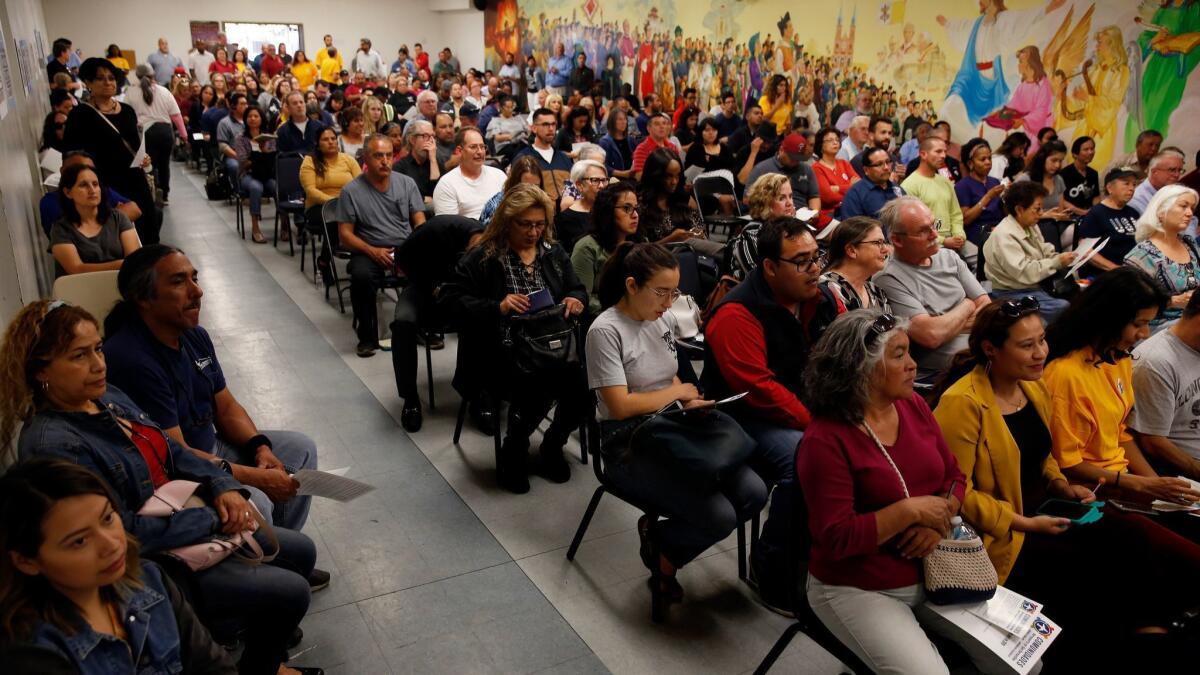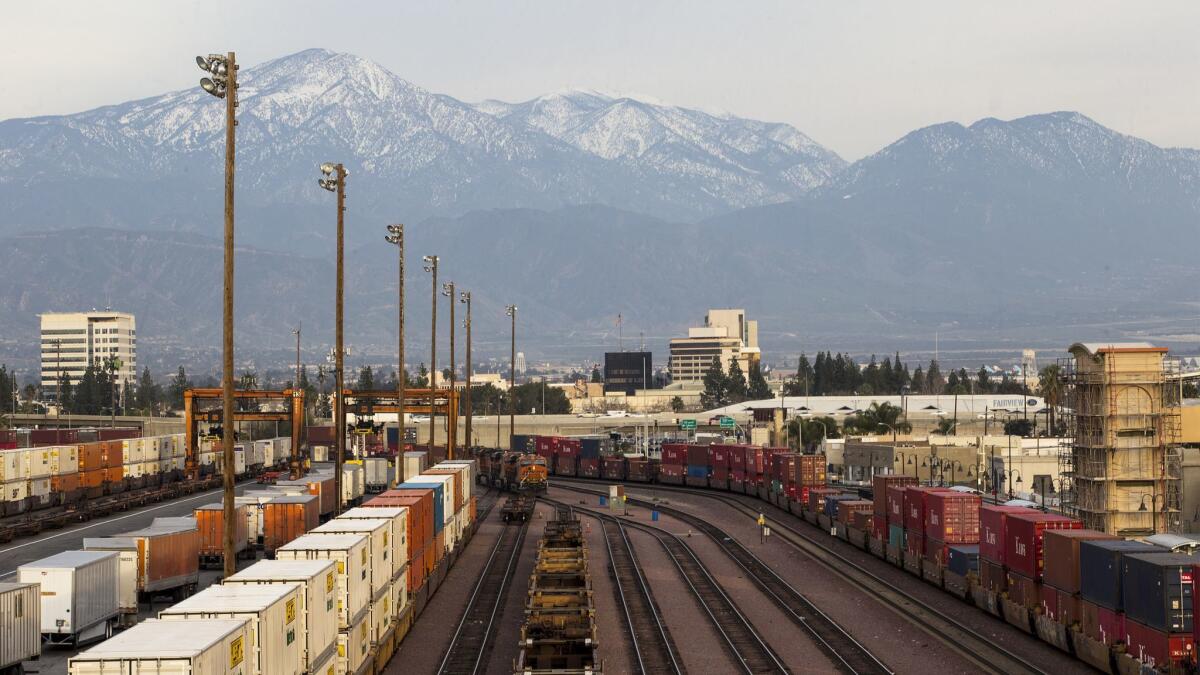Must Reads: Battles erupt over warehouse jobs as the Legislature moves to curb subsidies

- Share via
Hundreds of residents packed a church hall in San Bernardino a few weeks ago to hear community leaders rail against a huge new logistics center planned for the town’s airport.
The $200-million air cargo facility, the size of 11 football fields, could eventually generate some 3,800 jobs, garnering $6.5 million a year in revenue for the publicly owned airport on the site of the long-shuttered Norton Air Force base. But what kind of jobs, residents wanted to know: low-paid part-time jobs with no benefits? Jobs likely to be replaced by robots?
What about the pollution from 1,568 diesel-fueled truck trips a day and 26 daily cargo plane flights, which would blanket low-income neighborhoods already choked with toxic fumes?
And, by the way, why won’t officials reveal the name of the employer, rumored to be Amazon.com?
A spectacular boom in warehouses and distribution centers moving in over the last decade helped lift the vast Inland Empire region out of the Great Recession, bringing an estimated 84,000 jobs, nearly a quarter of the region’s added employment. Amazon built 14 giant fulfillment centers in Riverside and San Bernardino counties, becoming the area’s largest employer.

But massive industrial investments, while creating the nation’s largest logistics cluster, have come at a price. Cities often grant tens of millions of dollars in tax breaks, choice locations and other incentives to major retailers without ironclad contracts to guarantee jobs or benefits. Physicians label warehouse areas “diesel death zones” for the elevated cancer and asthma risks from truck and rail traffic funneling in goods from the giant ports of Los Angeles and Long Beach.
“Local governments compete to bring in logistics centers,” said Assemblyman Jose Medina (D-Riverside), who says companies like Amazon benefit from the bidding wars. “The promised number of jobs often doesn’t materialize. And many of the jobs are temporary or seasonal. They come with poor benefits and are at risk of becoming automated.”
A Medina-authored bill that passed the Assembly this month and is pending before the Senate would break through the secrecy that routinely cloaks economic development agreements. Under the measure, when warehouses are granted subsidies of $100,000 or more, local government agencies would be required to publicly reveal the number, wages and kinds of jobs promised — whether full-time, part-time or temporary — along with plans for automation, all information that companies now see as proprietary.
The legislation, AB 485, would mandate annual public hearings and reports on the incentive deals, projected tax revenue and progress in meeting job commitments. Local governments would have to publicize measures to claw back money from businesses if goals are not met.
Last year, a similar bill sped through both houses of the Legislature with little opposition. But Gov. Jerry Brown vetoed the measure, saying it went “too far by adding reporting rules that will be overly burdensome to a single industry.”
The pushback against what critics like to call corporate welfare may gain momentum from last year’s uproar over the nationwide competition for Amazon’s second headquarters and the secrecy imposed by the e-commerce giant on negotiations with hundreds of cities. The debate culminated this February when Amazon pulled out of a deal to locate 25,000 headquarters jobs in New York after legislators and community groups objected to a $3-billion government subsidy package.
We need these logistics jobs for marginally educated workers. What’s the alternative? A minimum wage job at a retail store?
— John Husing, chief economist, Inland Empire Economic Partnership
But to many in Riverside and San Bernardino counties, warehouse jobs are crucial to a region where 45% of the adult population has no more than a high school diploma.
“We need these logistics jobs for marginally educated workers,” said John Husing, chief economist for the Inland Empire Economic Partnership, an industry-affiliated group. “What’s the alternative? A minimum wage job at a retail store?”
Critics’ contention that many of the jobs are benefit-free temporary positions filled through staffing agencies is “nonsense,” Husing said. “Amazon has created 20,000 new jobs, and those are full-time.” The median local wage for wholesale trade workers with just a high school degree and little training — a category that includes logistics workers — is $15.12 an hour, with half earning less and half earning more, he added.
Husing sees the Medina bill, which is backed by the California Labor Federation, as “an attempt by a liberal Democrat to stop or slow down the projects.” The Chamber of Commerce calls the bill “extremely onerous,” adding that “public disclosure of this sensitive information would put businesses which choose to operate in California at a competitive disadvantage.”
Medina’s proposal is limited to transparency measures. A more radical bill, authored by Sen. Stephen Glazer (D-Orinda), passed the Senate Thursday and is pending in the Assembly. SB 531 would outright prohibit any new agreements that give online retailers a share of the sales tax California cities collect on goods the retailers sell and ship to customers across the state.
A twist in California tax law allows cities to return to corporations part of their sales tax payments, based on operations they have in those cities. That creates an incentive for retailers to assign sales to cities where warehouses are based, rather than where their products eventually wind up. According to a study commissioned by the California League of Cities, which supports the Glazer bill, these tax breaks amount to more than $1 billion a year — money that would otherwise go into public coffers.
“State and local governments are scrambling to fund public safety, roads, affordable housing and tackling the homeless crisis,” Glazer said. “The gains from these agreements are doubtful.”
However, Inland Empire officials argue that it’s only fair that the tax-sharing pacts encourage companies to assign their sales tax payments to warehouse locations, since those communities bear higher infrastructure costs to support the logistics industry and they suffer more from the pollution generated by trucks and trains.
Ontario, with more than 40 warehouses and distribution centers, has 10 tax revenue-sharing deals listed on its website. “We need these tools to compete with other states and regions,” said John Andrews, the city’s economic development director.
He cited a pact that granted QVC, the home-shopping giant, more than half of the sales tax it would generate from moving its $130-million Western distribution center to Ontario in 2015. Was the deal too generous? “QVC was also looking at locations in Arizona and Nevada,” Andrews said.

At the San Bernardino gathering, leaders of community, labor and environmental organizations did not advocate scrapping the airport development altogether. But new logistics facilities, they argued, should come with “community benefits agreements” guaranteeing well-paid, stable jobs and measures limiting air pollution, including air filters and soundproofing for schools and residences.
Unions want the new employer, whoever it may be, to allow them to organize workers. “The logistics industry has depressed wages and created a highly contingent and transitional workforce,” said Randy Korgan, secretary-treasurer of Teamsters Local 1932, which seeks to expand its representation of warehouse workers.
Last October, Amazon, which has fought attempts to unionize its workforce, set its starting wage at $15 an hour, but many warehouses and distribution centers pay less. According to a widely used standard created by MIT to measure local living costs and wages, an Inland Empire family with one working adult and a child would need a full-time job paying $26.94 an hour to make ends meet.
A February report by the Washington, D.C.-based Brookings Institution concluded: “Among large regions, the Inland Empire consistently ranks nearly last on measures of prosperity and economic inclusion,” noting the area’s below-average earnings in logistics as well as healthcare, hospitality and retail.
“Our region has been inundated by warehouses,” said Tom Dolan, executive director of the Inland Congregations United for Change, a coalition of 60 religious groups. “Because of the Inland Empire’s poverty and history of political corruption, all of the developments have been done with little to no community engagement.”
Although negotiations to build the airport cargo center began two years ago, and an environmental impact review was approved by the airport commission last October, community groups first learned about the development through a local news story in February.
Approvals for the project to be built by Texas-based Hillwood Enterprises for an unnamed tenant “had been passed before anyone knew anything about it,” Dolan said. “Everything was secret.”
Michael Burrows, executive director of Inland Valley Development Agency and the San Bernardino International Airport, disputed the secrecy charge. The environmental impact statement was advertised in a local newspaper, although no one showed up to ask questions at a public hearing, he said. The commission approved the ground lease agreement at a public meeting in December.

The air cargo facility does not involve public subsidies, according to Burrows, and the Federal Aviation Administration requires the land to be leased at fair market value. Regional air quality authorities are requiring diesel trucks serving the facility to be no older than 2010 models, which have cleaner engines than earlier models.
As for the identity of the tenant, Hillwood, which has built and leased 23 warehouses in San Bernardino since 2002, is negotiating with several possible occupants. “I hear people say it is Amazon,” Burrows said, noting that the e-commerce giant, which has been expanding its air freight operations, already has three fulfillment centers in the city. “But we don’t have a signed agreement with an end user yet.”
Could a community benefits agreement be attached to the lease? Burrows said he doesn’t know if the airport authority, which is controlled by the county and nearby cities, has the power to require one.
Several community benefit agreement models were touted in a UCLA study last year. One was a 2001 pact between Staples Center and 30 Los Angeles community groups requiring “living wage” jobs, affordable housing, a public plaza — and annual compliance reports.
As an example of what not to do, the study cited Ontario’s “astounding” QVC deal, negotiated “quietly with limited public outreach.” In exchange for 41 years of tax rebates, a city report estimated the company would create 522 full-time and 400 to 500 part-time jobs.
According to a Bloomberg Tax investigation into California tax breaks for online retailers, Ontario projects the city could earn a net $82 million a year from QVC sales taxes, after diverting $112 million a year back to the company and $10.25 million a year to a Long Beach lawyer who brokered the deal.
The actual contract signed between QVC and Ontario did not specify any job numbers. According to Sheheryar Kaoosji, co-executive director of the Ontario-based nonprofit Warehouse Worker Resource Center, counts of employee cars during repeated visits to QVC’s parking lot reveal that no more than 500 jobs have been created.
“This ‘low road’ approach to economic development contributes to the city’s high level of poverty, keeps the city’s tax base low, and fails to capitalize on civic engagement to improve the quality of life for workers and residents,” the UCLA study asserted.
Andrews, the Ontario economic development director, said QVC is “ramping up jobs over time. They are on track to reach 800 in the next year.”
If the city had not negotiated the tax deal, “they weren’t going to come at all,” he added. “And we would not be sharing in the sales tax revenue they are generating.”
On the afternoon of the church hall meeting, Anthony Victoria, 27, a staffer with the Center for Community Action and Environmental Justice, a local nonprofit, knocked on doors in a neighborhood of low-slung bungalows with peeling paint and chain link-fenced yards, inviting residents to come learn about the airport project.
Few of them had heard of it.
“It’s alarming,” Victoria said. “There’s just a continuing thing of leaving out public participation.
“We’re not against development,” he added. “But we want smart development.”
Twitter: @margotroosevelt
More to Read
Inside the business of entertainment
The Wide Shot brings you news, analysis and insights on everything from streaming wars to production — and what it all means for the future.
You may occasionally receive promotional content from the Los Angeles Times.










